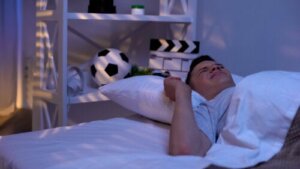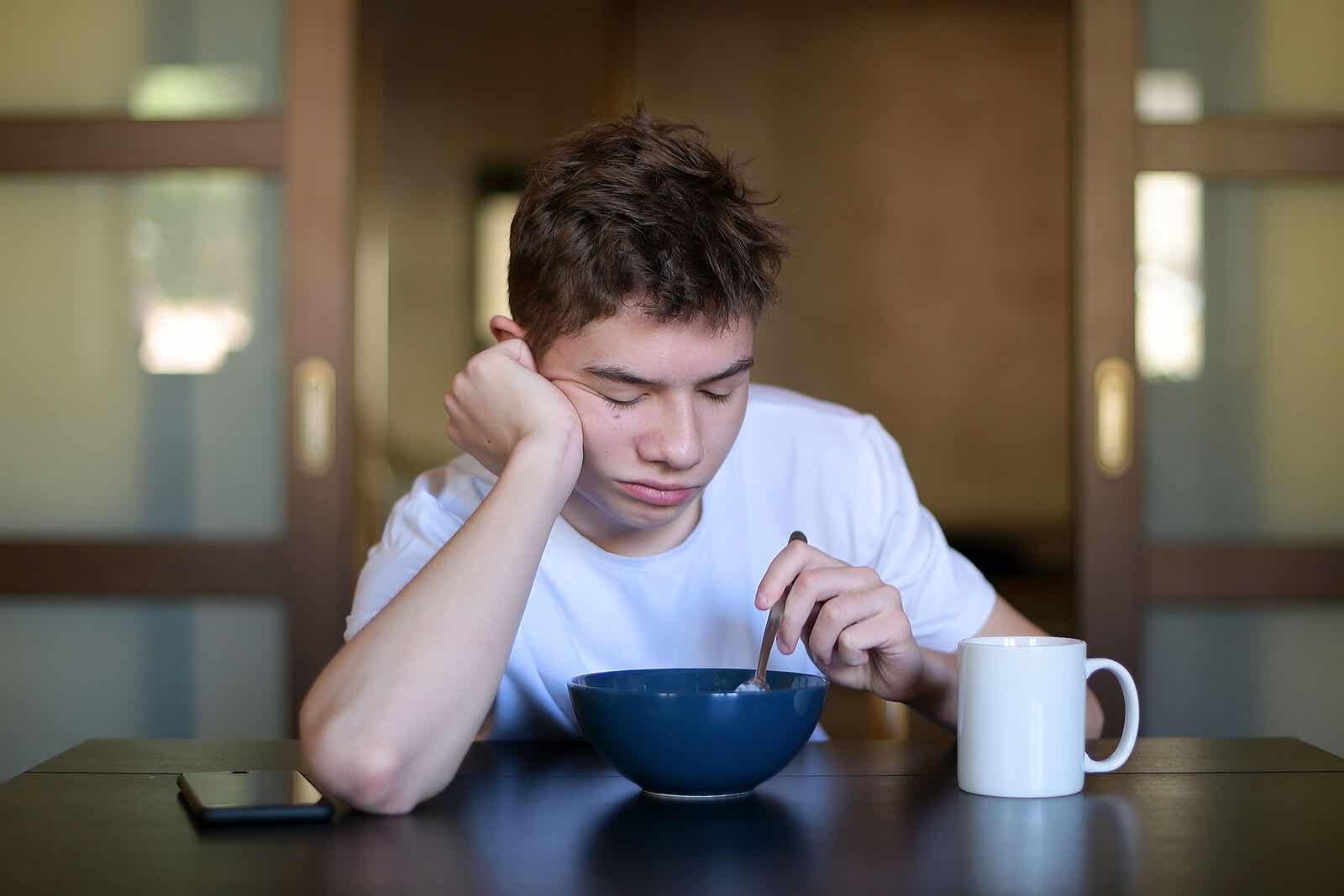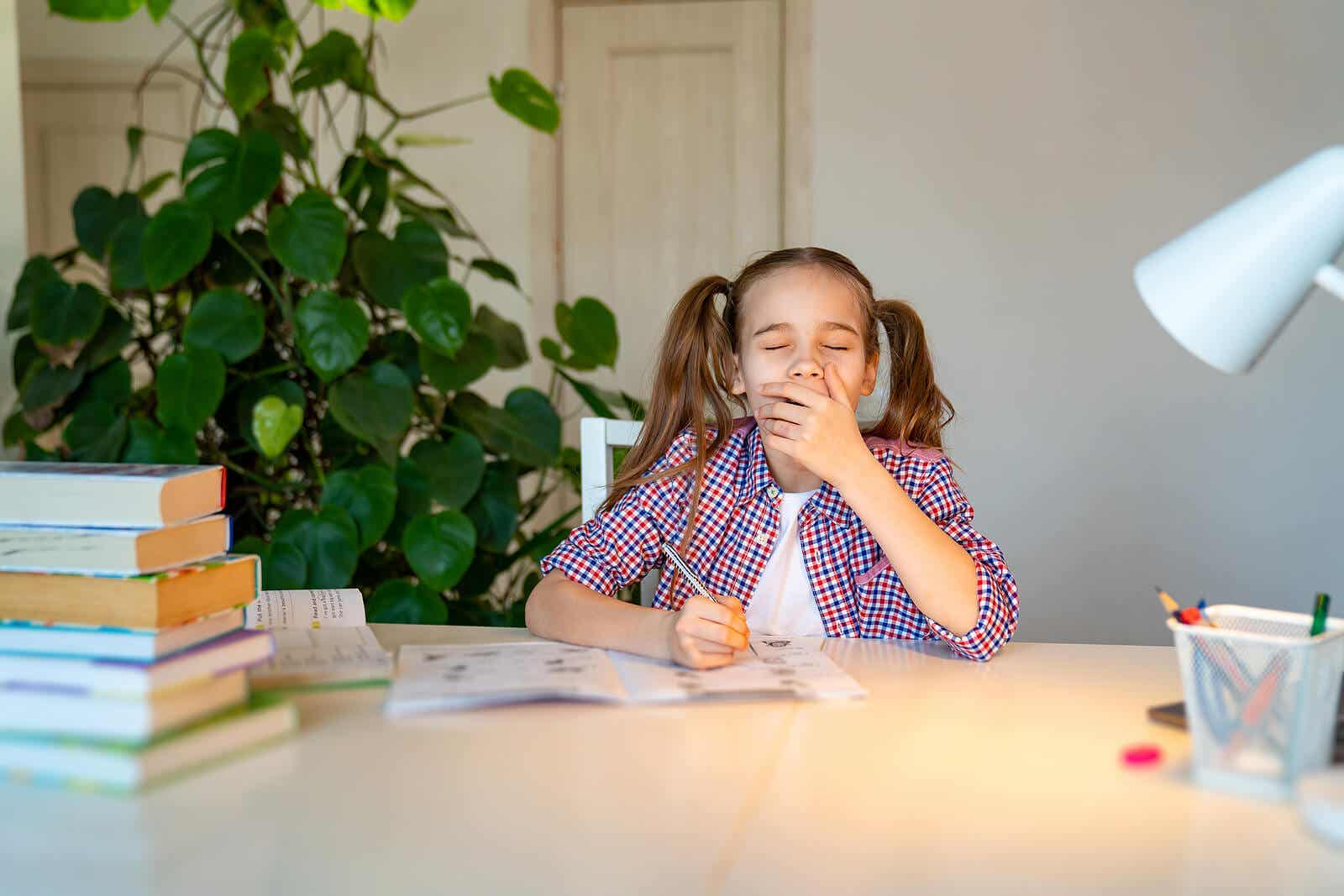Sleep Problems in Adolescents

Sleep problems in adolescents are becoming more and more common in our society. What are the most frequent problems or disorders? What are their consequences? How can they be prevented or avoided? Below, we’ll analyze and answer these questions.
But before covering this topic, it should be noted that, in general, adolescents need approximately 9 to 10 hours of sleep per day for a healthy and balanced development. Otherwise, daytime functioning can be severely impaired. And this can lead to a host of negative consequences, both physical and psychological.
Therefore, controlling adolescent sleep isn’t a trivial matter, but an aspect that must be taken care of and given the importance it deserves.
Sleep problems in adolescents
According to Marián Martínez Martínez and Mónica González Martínez (2014), doctors at the Sleep Disorders and Ventilation Unit of the Marqués de Valdecilla University Hospital in Spain, some of the most common sleep problems among adolescents are the following:

- Chronic sleep deprivation: This consists of presenting an accumulated sleep deficit due to not getting enough sleep throughout the week.
- Insomnia: Difficulties in falling asleep and staying asleep. A lack of restorative sleep, early awakening, or fragmented sleep are frequently observed.
- Narcolepsy: There’s excessive daytime sleepiness and sudden sleep attacks. It’s usually accompanied by cataplexy, sleep paralysis, and hypnagogic hallucinations (auditory or visual hallucination), and hypnopompic hallucinations (occurring in a state between sleep and wakefulness).
- Idiopathic hypersomnia: This is similar to the previous sleep problem we’ve discussed. Excessive daytime sleepiness is also experienced, despite getting enough sleep. But no other symptoms characteristic of narcolepsy are experienced.
- Restless legs syndrome and periodic leg movements: This consists of experiencing an unpleasant and uncomfortable sensation in the legs during sleep, which causes an uncontrollable urge to move these extremities frequently.
- Parasomnias: These are behavioral disorders that occur during sleep, such as night terrors, sleepwalking, confusional awakenings, sleep paralysis, among others.
If you suspect any of these sleep problems in adolescents, it’s important to immediately contact a specialist. They’ll be responsible for providing the appropriate treatment for each case.
The consequences of sleep problems in adolescents
Those adolescents who suffer from sleep deprivation or sleep deficit due to some of the problems we’ve just discussed may experience multiple consequences that directly affect the proper functioning of the mind and body. Some of the most common are the following:
- Daytime sleepiness
- Constant fatigue
- Irritability and tension
- Increased likelihood of developing mood disorders
- Poor academic performance
- Sudden behavioral changes
- Loss of memory
- Poor concentration or attention span
- Social problems
- Increased risk of abusing stimulant substances, such as coffee or energy drinks

Recommendations for establishing good sleep hygiene
To prevent sleep problems in adolescence from getting worse, or simply to prevent them from appearing, it’s important for young people to establish good sleep hygiene, following these guidelines:
- Don’t do intense physical exercise in the final hours before going to bed.
- Have a regular schedule for getting up and going to sleep.
- Don’t make copious and late-night dinners.
- Don’t drink coffee, tea, alcohol, energy drinks, or drinks with cola before going to sleep.
- Sleep in a well-ventilated room that’s at a pleasant temperature.
- Do relaxing activities before going to bed, such as reading, listening to music, meditation…
- Use the bed only for sleeping.
- Don’t play video games, watch TV, or use the computer, cell phone, or tablet excessively just before going to bed or in the wee hours of the morning.
However, as parents, trying to change the sleep habits of adolescents can be a challenge. Therefore, it’s best for these measures to be put into practice from the first years of life, so that the child becomes accustomed to following certain sleep hygiene guidelines from an early age and, when they reach adolescence, these become part of their daily routine.
Sleep problems in adolescents are becoming more and more common in our society. What are the most frequent problems or disorders? What are their consequences? How can they be prevented or avoided? Below, we’ll analyze and answer these questions.
But before covering this topic, it should be noted that, in general, adolescents need approximately 9 to 10 hours of sleep per day for a healthy and balanced development. Otherwise, daytime functioning can be severely impaired. And this can lead to a host of negative consequences, both physical and psychological.
Therefore, controlling adolescent sleep isn’t a trivial matter, but an aspect that must be taken care of and given the importance it deserves.
Sleep problems in adolescents
According to Marián Martínez Martínez and Mónica González Martínez (2014), doctors at the Sleep Disorders and Ventilation Unit of the Marqués de Valdecilla University Hospital in Spain, some of the most common sleep problems among adolescents are the following:

- Chronic sleep deprivation: This consists of presenting an accumulated sleep deficit due to not getting enough sleep throughout the week.
- Insomnia: Difficulties in falling asleep and staying asleep. A lack of restorative sleep, early awakening, or fragmented sleep are frequently observed.
- Narcolepsy: There’s excessive daytime sleepiness and sudden sleep attacks. It’s usually accompanied by cataplexy, sleep paralysis, and hypnagogic hallucinations (auditory or visual hallucination), and hypnopompic hallucinations (occurring in a state between sleep and wakefulness).
- Idiopathic hypersomnia: This is similar to the previous sleep problem we’ve discussed. Excessive daytime sleepiness is also experienced, despite getting enough sleep. But no other symptoms characteristic of narcolepsy are experienced.
- Restless legs syndrome and periodic leg movements: This consists of experiencing an unpleasant and uncomfortable sensation in the legs during sleep, which causes an uncontrollable urge to move these extremities frequently.
- Parasomnias: These are behavioral disorders that occur during sleep, such as night terrors, sleepwalking, confusional awakenings, sleep paralysis, among others.
If you suspect any of these sleep problems in adolescents, it’s important to immediately contact a specialist. They’ll be responsible for providing the appropriate treatment for each case.
The consequences of sleep problems in adolescents
Those adolescents who suffer from sleep deprivation or sleep deficit due to some of the problems we’ve just discussed may experience multiple consequences that directly affect the proper functioning of the mind and body. Some of the most common are the following:
- Daytime sleepiness
- Constant fatigue
- Irritability and tension
- Increased likelihood of developing mood disorders
- Poor academic performance
- Sudden behavioral changes
- Loss of memory
- Poor concentration or attention span
- Social problems
- Increased risk of abusing stimulant substances, such as coffee or energy drinks

Recommendations for establishing good sleep hygiene
To prevent sleep problems in adolescence from getting worse, or simply to prevent them from appearing, it’s important for young people to establish good sleep hygiene, following these guidelines:
- Don’t do intense physical exercise in the final hours before going to bed.
- Have a regular schedule for getting up and going to sleep.
- Don’t make copious and late-night dinners.
- Don’t drink coffee, tea, alcohol, energy drinks, or drinks with cola before going to sleep.
- Sleep in a well-ventilated room that’s at a pleasant temperature.
- Do relaxing activities before going to bed, such as reading, listening to music, meditation…
- Use the bed only for sleeping.
- Don’t play video games, watch TV, or use the computer, cell phone, or tablet excessively just before going to bed or in the wee hours of the morning.
However, as parents, trying to change the sleep habits of adolescents can be a challenge. Therefore, it’s best for these measures to be put into practice from the first years of life, so that the child becomes accustomed to following certain sleep hygiene guidelines from an early age and, when they reach adolescence, these become part of their daily routine.
All cited sources were thoroughly reviewed by our team to ensure their quality, reliability, currency, and validity. The bibliography of this article was considered reliable and of academic or scientific accuracy.
- Martínez-Martínez, M. y González-Martínez, M. (2014). Sueño en el adolescente. Revista de Formación Continuada de la Sociedad Española de Medicina de la Adolescencia, 2(2), 59-66.
- Pin-Arboledas, G., Morell-Safort, M. y Mompó-Marabotto, L. (2013). El insomnio del adolescente. Revista de Formación Continuada de la Sociedad Española de Medicina de la Adolescencia, 1 (3), 30-41.
This text is provided for informational purposes only and does not replace consultation with a professional. If in doubt, consult your specialist.








